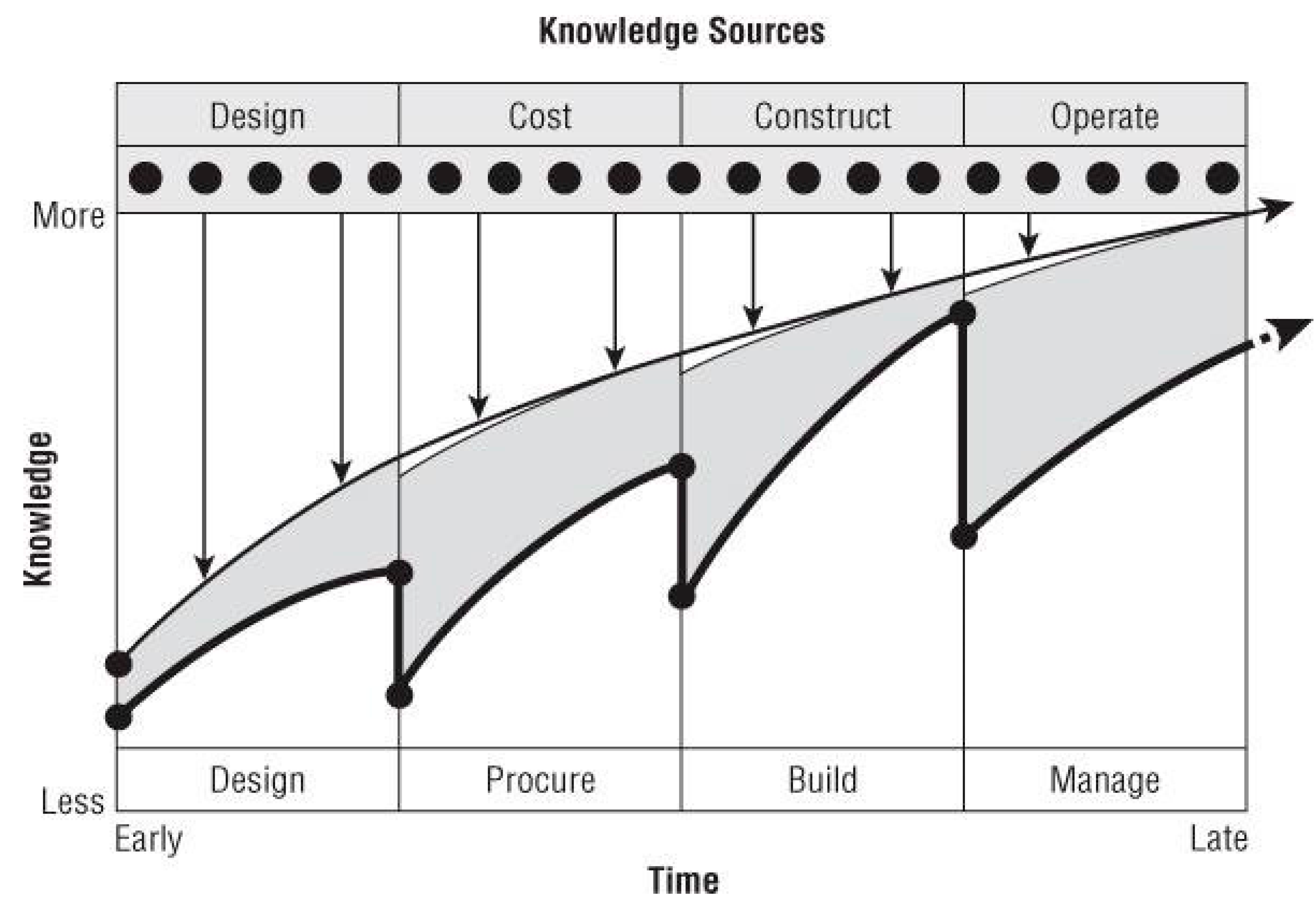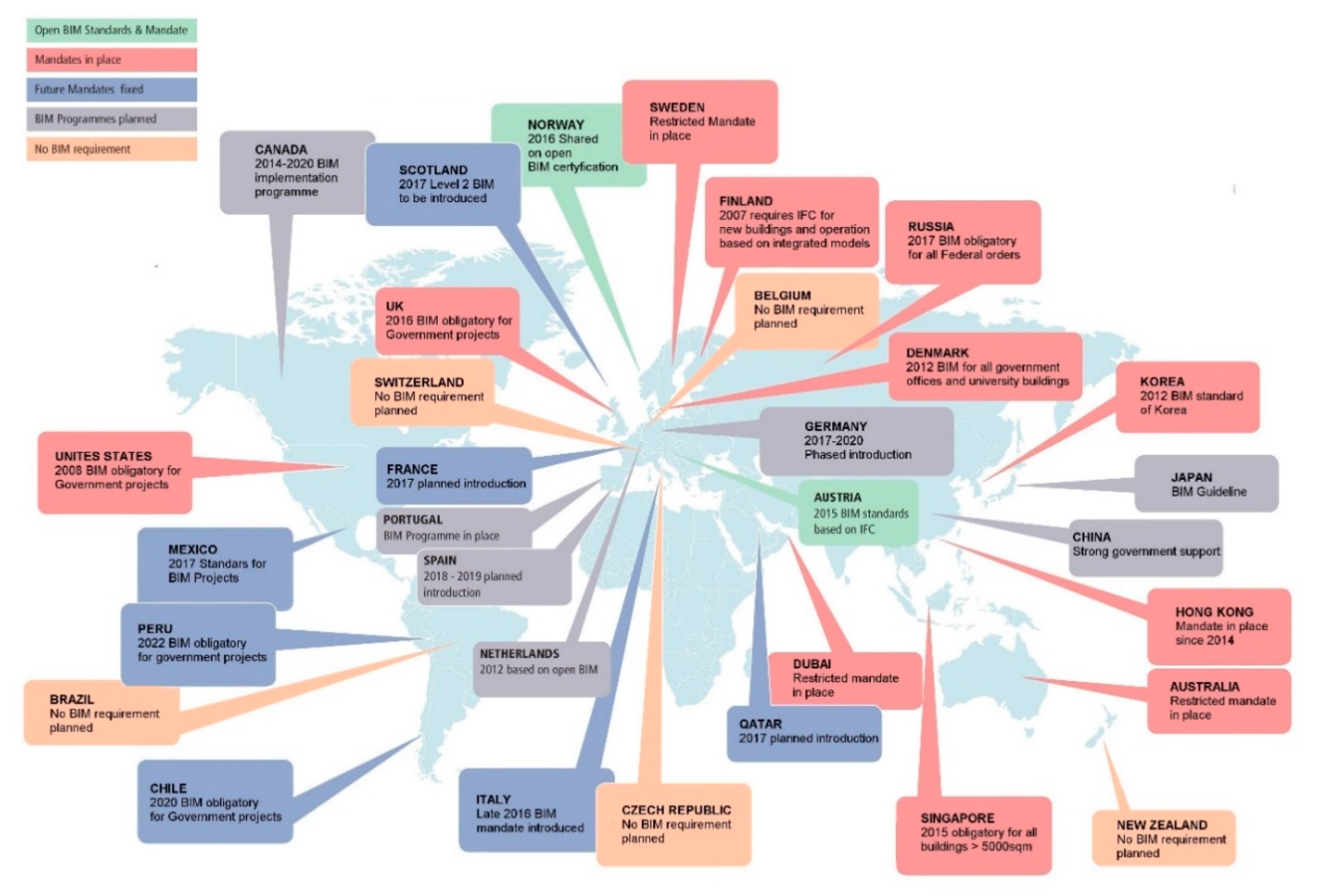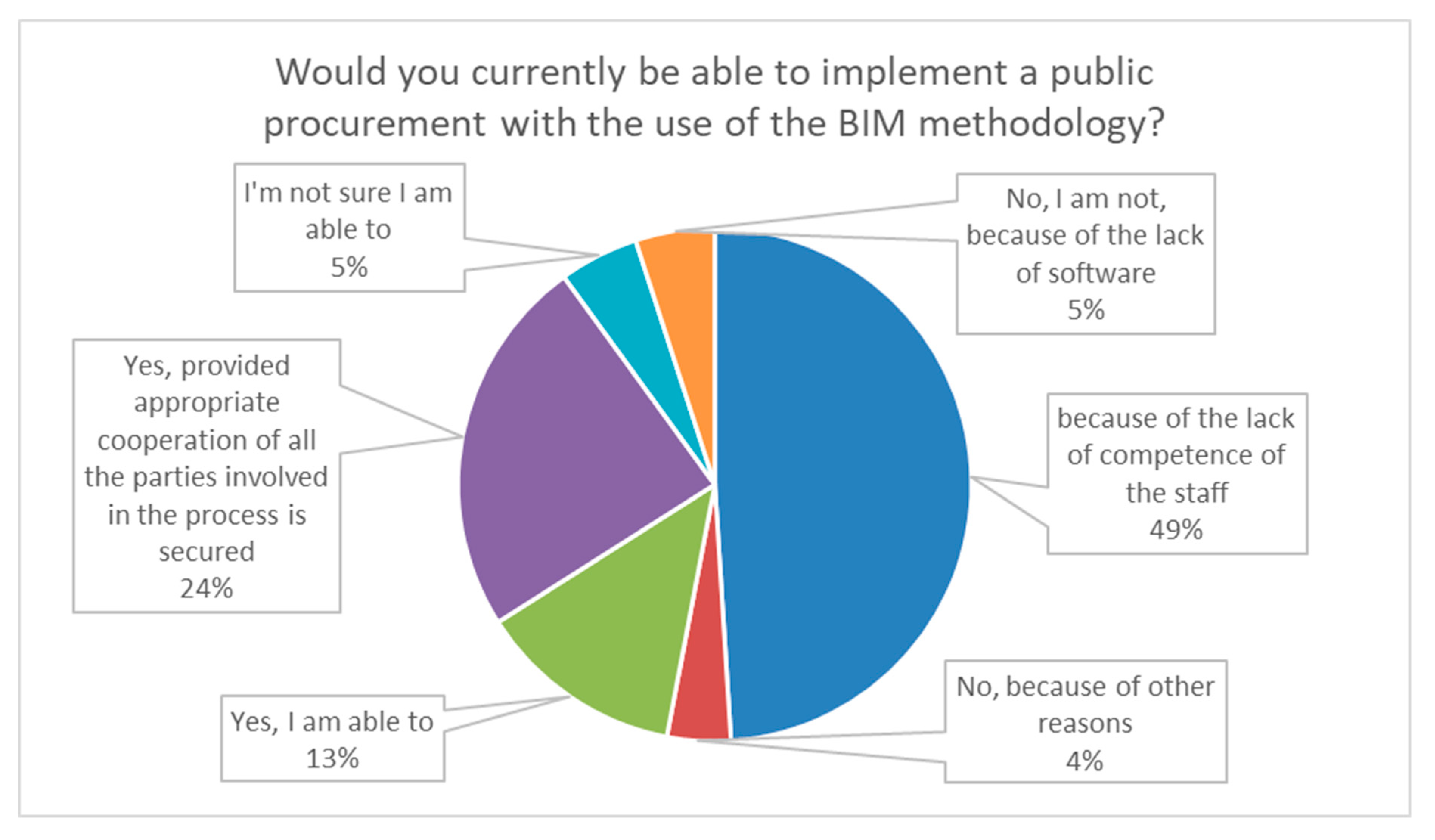A SWOT Analysis of the Use of BIM Technology in the Polish Construction Industry
Abstract
1. Introduction
2. Methods—SWOT Analysis
- External positive (Opportunities)—opportunities (development opportunities in the environment).
- Internal positive (Strengths)—strengths of the organization.
- External negative (Threats)—environmental hazards.
- Internal negative (Weaknesses)—weaknesses of the organization.
- STAGE I—Identification of factors related to the implementation of BIM as positive or negative for the construction project and its environment, and assessment of these factors on a numerical scale from 1 to 5 where: 1—very weak factor influence, 5—very strong factor influence.
- STAGE II—Assessment of the strategic situation of the BIM method.
- STAGE III—Identification of the strategic tasks and actions by combining and analyzing the strengths and weaknesses of the BIM technology with opportunities and threats by using the strengths of BIM to obtain maximum benefits from the opportunities offered by the environment, overcoming the weaknesses by using the opportunities that exist in the environment, using the strengths of BIM to avoid threats from the environment, and minimizing the effects of the existence of BIM weaknesses to avoid risks from the environment.
3. BIM Technology
4. BIM Adoption in the World
5. The SWOT Analysis of the Use of BIM Technology in Poland
5.1. Stage I—Identification of Factors
- In October 2015 [10] on behalf of Autodesk, the Millward Brown Institute conducted a study in a group of 350 companies from the architectural and construction industry (architectural studios, construction design and installation companies, and development companies), called “BIM—Polish perspective”.
- In October 2019 [11] on a sample of 287 companies, the Kantar Poland Institute (commissioned by Autodesk) prepared and published a study “BIM, cooperation, cloud in Polish construction”.
5.1.1. STRENGTHS (S)
Better Quality of Documentation
Reduction of Construction Project Costs
Reduction of Construction Material Waste
Automation of the Drawing Process
5.1.2. WEAKNESSES (W)
No Universal Software Platform
High Labor Consumption of Developing the Correct BIM Model
Errors in Reflecting the True Form of a Building
High Implementation Costs of BIM in a Company
5.1.3. OPPORTUNITIES
High Interest of the Construction Market Leaders
Implementation of the BIM Technology in a Number of Countries
Developing Higher Awareness among All Stakeholders
Students’ Education about BIM
5.1.4. THREATS
No Legal Regulations and Binding Standards Regarding BIM in Poland
Lack of Qualified and Experienced Staff
Unwillingness of the Contractors/Clients/Users to Use BIM
5.2. Stage II—Assessment of the Strategic Situation of the BIM Method
5.3. Stage III—Defining Strategic Tasks and Actions
6. Summary and Conclusions
Author Contributions
Funding
Conflicts of Interest
References
- Isikdag, U.; Zlatanova, S. A SWOT analysis on the implementation of Building Information Models within the Geospatial Environment. In Urban and Regional Data Management—UDMS Annual 2009; Krek, A., Rumor, M., Zlatanova, S., Fendel, E.M., Eds.; Taylor & Francis Group: Boca Raton, FL, USA, 2009; pp. 15–30. [Google Scholar]
- Thompson, A.A.; Strickland, A.J.; Gamble, J.E. Crafting and Executing Strategy-Concepts and Cases, 15th ed.; McGraw-Hill/Irwin: Boston, MA, USA, 2007. [Google Scholar]
- Gürel, E.; Tat, M. SWOT analysis: A theoretical review. J. Int. Soc. Res. 2017, 10, 994–1006. [Google Scholar] [CrossRef]
- US National Institute of Building Sciences. National Building Information Modelling Standard; Version 1—Part 1: Overview, Principles, and Methodologies, Glossary; US National Institute of Building Sciences: Washington, DC, USA, 2007. [Google Scholar]
- Ratajczak, J.; Riedl, M.; Matt, D.T. BIM-based and AR Application Combined with Location-Based Management System for the Improvement of the Construction Performance. Buildings 2019, 9, 118. [Google Scholar] [CrossRef]
- Elagiry, M.; Marino, V.; Lasarte, N.; Elguezabal, P.; Messervey, T. BIM4Ren: Barriers to BIM Implementation in Renovation Processes in the Italian Market. Buildings 2019, 9, 200. [Google Scholar] [CrossRef]
- Juszczyk, M.; Zima, K.; Lelek, W. Forecasting of sports fields construction costs aided by ensembles of neural networks. J. Civ. Eng. Manag. 2019, 25, 715–729. [Google Scholar] [CrossRef]
- Nawari, O.N.; Ravindran, S. Blockchain and Building Information Modeling (BIM): Review and Applications in Post-Disaster Recovery. Buildings 2019, 9, 149. [Google Scholar] [CrossRef]
- Liu, Z.; Lu, Y.; Peh, L.C. A Review and Scientometric Analysis of Global Building Information Modeling (BIM) Research in the Architecture, Engineering and Construction (AEC) Industry. Buildings 2019, 9, 210. [Google Scholar] [CrossRef]
- BIM–polska perspektywa. Raport z badania / BIM - Polish Perspective. Research Report. Available online: http://damassets.autodesk.net/content/dam/autodesk/www/campaigns/bim-event/BIM_raport_final.pdf (accessed on 14 October 2019).
- BIM, współpraca, chmura w polskim budownictwie / BIM, Cooperation, Cloud in Polish Construction. Available online: https://www.autodesk.pl/campaigns/aec/bim-report-2019#form-section (accessed on 31 October 2019).
- Fan, S.L.; Skibniewski, M.J.; Hung, T.W. Effects of Building Information Modeling During Construction. J. Appl. Sci. Eng. 2014, 17, 157–166. [Google Scholar]
- Giel, B.K.; Issa, R.R.A. Return on Investment Analysis of Using Building Information Modeling in Construction. J. Comput. Civ. Eng. 2013, 27, 511–521. [Google Scholar] [CrossRef]
- Zima, K. Impact of information included in the BIM on preparation of Bill of Quantities. Procedia Eng. 2017, 208, 203–210. [Google Scholar] [CrossRef]
- Kapliński, O. An important contribution to the discussion on research methods and techniques in designing. Eng. Struct. Technol. 2015, 7, 50–53. [Google Scholar] [CrossRef]
- Kapliński, O. Innovative solutions in construction industry. Review of 2016–2018 events and trends. Eng. Struct. Technol. 2018, 10, 27–33. [Google Scholar] [CrossRef]
- Read, P.; Krygiel, E.; Vandezande, J. Mastering Autodesk® Revit® Architecture 2013; John Wiley & Sons: Ottawa, ON, Canada, 2012. [Google Scholar]
- McAuley, B.; Hore, A.; West, R. BICP Global BIM Study—Lessons for Ireland’s BIM Programme; Construction IT Alliance (CitA) Limited: Dublin, Ireland, 2017. [Google Scholar] [CrossRef]
- KPMG Advisory Sp. z o.o. Sp. k. Building Information Modeling. In Ekspertyza Dotycząca Możliwości Wprowadzenia BIM w Polsce; Ministerstwo Infrastruktury i Budownictwa/Expert Opinion on the Possibility of introducing BIM in Poland; Ministry of Infrastructure and Construction, KPMG Public: Amstelveen, The Netherlands, 30 September 2016. [Google Scholar]



| CAD Environment | BIM Technology |
|---|---|
| No link between drawings, any changes require manual correction | Parametric design allows automatic change of object and element parameters |
| 2D view, no visualization of the 3rd dimension (height of the object and its elements) | 3D, 4D, 5D, …, xD |
| The features of the elements are given by the designer. The drawing consists of 2D lines which are later interpreted as objects | Ready-made elements that already have their properties can be used. Specific relationships between the elements are established |
| Possibility of describing the properties of an element in a drawing or in a technical description for a project | The properties of the elements are correlated with the element and can be elicited at any time by selecting the element |
| Industry documentation is often created independently | The BIM model is a data source for all industries and integrates them |
| Collisions between industries are often detected only at the construction stage | Collisions between industries are detected at the design stage |
| Region/Continent | BIM Adoption Brief Characteristic |
|---|---|
| North America | In the US, BIM is mandatory since 2008—a definite leader in BIM adoption. In Canada, the BIM adoption program has been running from 2014 to today. North America apparently ranked as the most advanced continent in every approach. |
| South and Central America | It is planned to introduce BIM obligatory in government projects in the years 2020–2022 in a few countries. |
| Europe | Open BIM standards and mandate in a few countries (especially in Scandinavian countries and Great Britain), many countries are preparing to introduce BIM standards or to make BIM obligatory in public procurement). |
| Asia | Korea and Hong Kong are becoming leaders in the region, China and Japan have great government support in implementing BIM standards. The level of adoption on the continent, however, must be assessed low, despite these four strong leaders. |
| The Middle East | Unlike many Far East countries, BIM adoption in the Middle East is low. Individual projects are implemented, but there are no specific actions for the adoption of BIM in individual countries of the Middle East. |
| Africa | South African government’s growth targets in respect of technology usage in South Africa would be beneficial to BIM stakeholders. However, there is a lack of efforts to adopt BIM on the continent. Only representatives of architecture, engineering and construction (AEC) recommended the adoption of BIM techniques in Egypt, starting with the acquisition of full awareness of the BIM framework, different levels and BIM stages also in the perspective of the entire life cycle of construction projects. |
| Australia and Oceania | Mandate in place in Australia, in New Zealand there is government support and significant BIM promotion. |
| STRENGTHS (S) | WEAKNESSES (W) | ||
| Better documentation | 5 | No universal software platform | 2 |
| Reduction of costs of the construction project | 5 | High labor consumption of the correct BIM model | 5 |
| Reduction of construction material waste | 3 | Errors in reflecting the true form of the building | 4 |
| Automation of drawing execution | 4 | High costs of BIM implementation in a company | 1 |
| TOTAL | 17 | TOTAL | 12 |
| OPPORTUNITIES (O) | THREATS (T) | ||
| High interest of the leaders of the construction market | 4 | Lack of legal regulations and binding standards concerning BIM in Poland | 5 |
| Implementation of the BIM technology in many countries | 3 | Lack of qualified and experienced staff | 5 |
| Developing higher awareness among all stakeholders | 5 | Unwillingness of the contractors/clients/users to employ BIM | 3 |
| Educating students in BIM | 2 | - | - |
| TOTAL | 14 | TOTAL | 13 |
| Software Type | Example Software | Number (unit) | Unit cost (PLN/unit) | Cost (PLN) |
|---|---|---|---|---|
| Design | Archicad/Revit | 1 | 10,000 | 10,000 |
| Cost estimates | BIMestiMate | 3 | 2190 | 6570 |
| IFC browser | SMV/BIM Vision | 3 | 0 | 0 |
| TOTAL | 16,570 | |||
| STRENGTHS (S) | WEAKNESSES (W) | |
| 1. Creating better quality projects | 1. No common software platform | |
| 2. Decreasing the construction project costs | 2. High labour consumption of creating a correct BIM model | |
| 3. Decreasing the amount of construction waste | 3. Errors in reflecting the real form of the building | |
| 4. Automation of drawings | 4. High costs of BIM implementation in a company | |
| OPPORTUNITIES (O) | ||
| 1. High interest of the construction market leaders | S1O3—higher quality of projects should contribute to developing higher awareness of all participants in the project | W1O1—the interest of market leaders can help to create universal tools and software platforms |
| 2. Mandatory implementation of BIM in public procurement in many countries | S2O1—reducing the cost of construction projects will increase interest of market leaders in BIM technology | W2O4—education of students on BIM will allow to introduce to the market people able to quickly perform the correct BIM model |
| 3. Developing higher awareness among all stakeholders | S4O4—automation of work should increase students’ interest in BIM technology | W4O2—implementation of BIM in public procurement in Poland may result in increased investment in the implementation of BIM in the company |
| 4. Education of students in BIM | ||
| THREATS (T) | ||
| 1. No regulations or binding standards concerning BIM in Poland | S2T3—reduction of construction project costs should convince all the reluctant to introduce this technology | W1T1—the lack of a universal software platform may discourage the government from creating legal regulations and hinder the creation of the standards of conduct |
| 2. No qualified or experienced staff | S4T2—design automation should encourage young engineers in particular to learn the BIM technology | W2T3—high labor consumption and low wages may discourage designers from using BIM technology |
| 3. Unwillingness of the contractors/clients/users to use BIM | ||
| W4T2—high costs for software and staff training may discourage employers from training their staff | ||
© 2020 by the authors. Licensee MDPI, Basel, Switzerland. This article is an open access article distributed under the terms and conditions of the Creative Commons Attribution (CC BY) license (http://creativecommons.org/licenses/by/4.0/).
Share and Cite
Zima, K.; Plebankiewicz, E.; Wieczorek, D. A SWOT Analysis of the Use of BIM Technology in the Polish Construction Industry. Buildings 2020, 10, 16. https://doi.org/10.3390/buildings10010016
Zima K, Plebankiewicz E, Wieczorek D. A SWOT Analysis of the Use of BIM Technology in the Polish Construction Industry. Buildings. 2020; 10(1):16. https://doi.org/10.3390/buildings10010016
Chicago/Turabian StyleZima, Krzysztof, Edyta Plebankiewicz, and Damian Wieczorek. 2020. "A SWOT Analysis of the Use of BIM Technology in the Polish Construction Industry" Buildings 10, no. 1: 16. https://doi.org/10.3390/buildings10010016
APA StyleZima, K., Plebankiewicz, E., & Wieczorek, D. (2020). A SWOT Analysis of the Use of BIM Technology in the Polish Construction Industry. Buildings, 10(1), 16. https://doi.org/10.3390/buildings10010016







